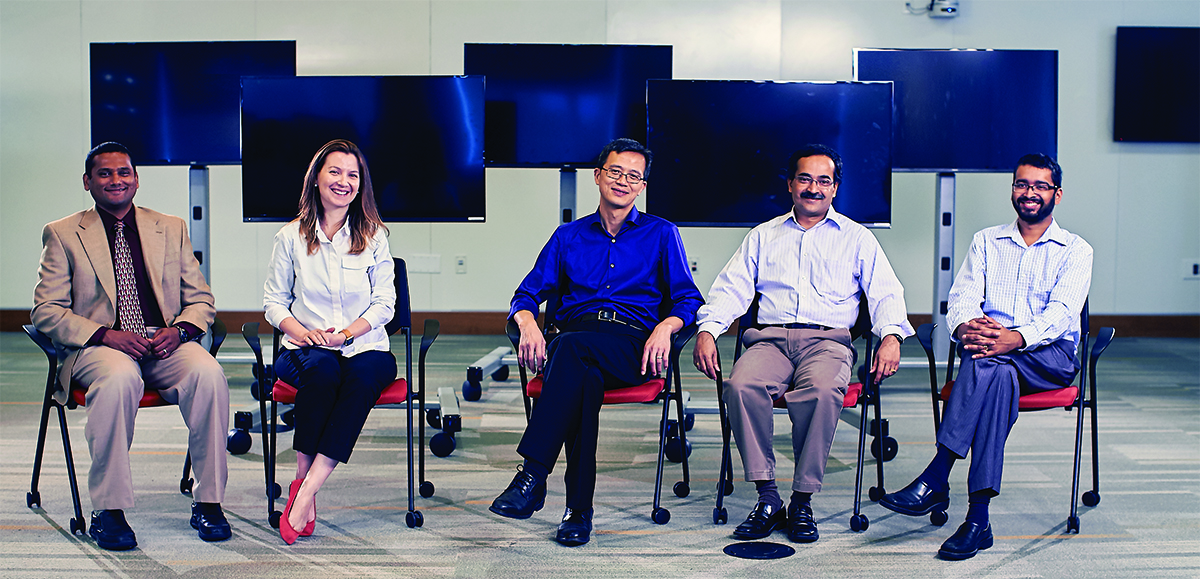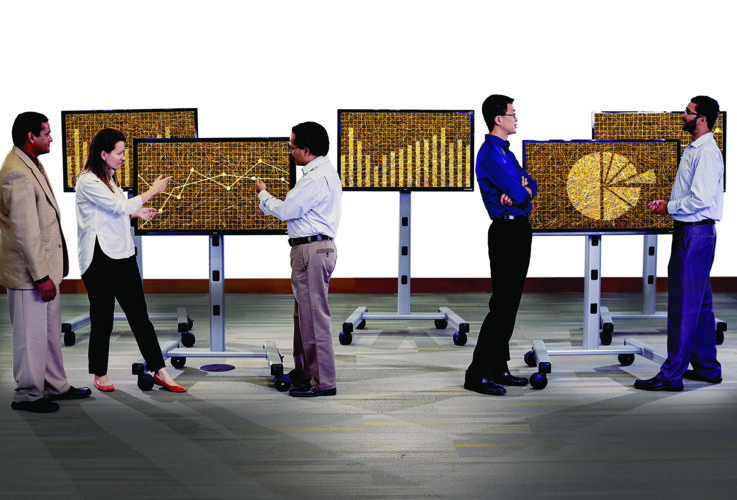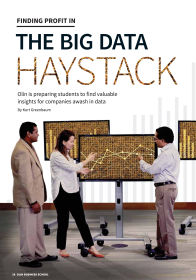This story, written by Kurt Greenbaum, originally appeared in the 2016 edition of Olin Business Magazine.
Buried in millions of lines of customer data collected from scanners, cash registers, patient records, online product reviews, wearable devices, and other sources, businesses in every industry are unearthing profit-generating insights unknowable just a decade ago.
Those insights range from the seemingly inconsequential—promoting beer actually increases the sale of diapers—to the staggering: creating cost-saving hospital systems to more efficiently pair nurses with incoming patients.
Mastering the emerging art of wrangling customer data is behind Olin’s Master of Science in Customer Analytics (MSCA) degree and its year-old Center for Customer Analytics and Big Data (CCABD). The MSCA program, which has full-time and part-time options, welcomed its third class of 32 students this fall, and has sent forth three dozen graduates, snapped up by companies that are starving for the expertise.
Help wanted: Big data analysts
A recent survey of 422 European and US executives by the Economist Intelligence Unit and Cognizant ranked big data analytics as the most important digital competency businesses will require by 2018. That puts big data skills ahead of security, mobile technology, and digital marketing. While demand will be high, US supply for analysts is expected to lag: McKinsey & Company forecasts a shortage of 140,000 to 190,000 analysts two years from now.
“They want more than nerds,” said Gregory J. Hutchings, Senior Advisor in Olin’s Weston Career Center. “They want people who can look at the data and draw quantitative and qualitative conclusions—and make strategic recommendations.”
Olin graduate Siri Zhan (MSCA ’16) has already experienced business’s hunger for talent. She started working for New Jersey-based Dressbarn as an analyst two months before receiving her degree.
“My manager told me they had the position open for six months without finding a qualified candidate,” said Zhan,who prepares monthly forecasts for sales promotions based on previous customer data. Strategies for coupon-based promotions are individualized for loyal customers versus rare visitors who might be “reactivated” with a more enticing offer. Zhan and classmate Drew Kaplan (MSCA ’16) both spoke of blending their passion for math and technology with the art of marketing and business problem solving. Their interest led them to Olin’s customer analytics graduate program.
WashU’s program was attractive because it was part of the business school—not a separate tech degree. “I didn’t want to look at data and run statistical analyses just to do it,” said Kaplan, who analyzes customer data for UPS in Atlanta. “I wanted to be grounded in business principles and solve real problems.”
Blue chip companies across numerous industry sectors have grabbed up Olin grads like Zhan and Kaplan, including Bain & Company, United Airlines, Emerson, Penn National Gaming, and The Walt Disney Company.
“Big data is the new oil. The companies, governments, and organizations that are able to mine this resource will have an enormous advantage over those that don’t.” -Pew study on the future of big data
Learning to deal with data
The CCABD and the master’s program form a one-two punch designed to prepare students and aid industry leaders in dealing with the new technology-driven tidal wave of customer data. Through consulting projects managed by the Center for Experiential Learning, MSCA students get hands-on experience solving real-world business problems focused on big data analysis. The client companies benefit from cutting-edge analysis and gain access to top-flight research from Olin faculty members who serve as advisors on projects.
Kaplan was the student team leader on a consulting project that helped analyze data from a retail supply company. The team’s recommendations included a segmentation strategy defining how the company should market to different types of customers.
In one project, Kaplan exercised a variety of technical, analytical, and marketing muscles. He wrote database queries to clean up and consolidate 5 million rows of purchase history. He applied mathematical concepts to frame each customer’s behavior across a variety of product categories. And the student team created tools for the client to provide product recommendations and personalized marketing for its half-million customers.
“It was a big, big part of my curriculum and what I got out of the program,” Kaplan said.
Working on another semester-long project, Zhan’s team analyzed online customer shopping patterns. Her team found the experience and feedback rewarding, noting, “The client said some of our conclusions were actually very new to them.”
These experiential learning opportunities are just one facet of the CCABD. Seethu Seetharaman, W. Patrick McGinnis Professor of Marketing, is Director of the center and Academic Director of the master’s program in customer analytics. He also sees the big data boom as a perfect moment for collaboration between faculty researchers and companies of all sizes. “The big data movement is here to stay,” said Seetharaman. “The timing is right for us to inform and educate companies in this area.”

Some of the Olin professors involved in big data research and teaching, left to right: Durai Sundaramoorthi, Senior Lecturer in Management; Yulia Nevskaya, Assistant Professor of Marketing; Tat Chan, Associate Professor of Marketing ; Seethu Seetharaman, W. Patrick McGinnis Professor of Marketing; Arun Gapalakrishnan, Assistant Professor of Marketing
Data is gold mine for research
Both the master’s degree program and the big data center draw on cross-campus partnerships with the Technology and Leadership Center, the School of Engineering & Applied Science, Data and GIS Services, and the University Library. Faculty from a variety of disciplines partner or partake in research projects exposing the real-world and practical business applications of big data analysis.
“The data is exploding,” said Durai Sundaramoorthi, Senior Lecturer in Management, who has extensive experience in the healthcare industry. He teaches predictive analytics to MSCA students and shows them how to find unexpected relationships that can unlock sales strategies previously opaque to marketing professionals. “The human brain cannot process the relationship among so many variables.”
For example, that seemingly random link between beer and diapers illustrates the power of once invisible cross-category connections. “Analytics help to unearth these patterns from the data,” Sundaramoorthi explains. “Without analytics, we wouldn’t know these interesting cross-category relationships.”
These researchers bring concepts such as predictive modeling, probability analysis, and predictions about customer risk to the nitty gritty work of slicing and dicing the mega sets of data now available. Then they mine the results to create strategies for pricing, inventory, targeted marketing, and logistics that can drive company profits.
Sundaramoorthi’s research with a Texas hospital cross-referenced the minute-by-minute movement of nurses—using data from now-commonplace wearable scanners—with patient records, creating a cost-saving algorithm for nursing assignments.
“Slowly, companies are learning that data can be used to make themselves more efficient or more profitable,” Sundaramoorthi said.
One of Seetharaman’s recent research projects examined millions of purchases from a national grocery chain’s loyalty card database. Cross-referencing products purchased from 800 households in 28 categories over nearly two years, Seetharaman and his research partners looked at which coupon strategies would bump profits the most. The result: Coupon bundles around a theme such as “back to school” yield higher profits on a per-customer basis, but overall, a store can expect a 27 percent profit bump from coupons customized to individual customers.
Tat Chan, Associate Professor of Marketing at Olin, has researched a month’s worth of data from Chinese online retailer Taobao, tracking a million consumers and their online product search patterns. Through his research, he’s developed strategies for segmenting online customers as “high” vs. “low” value, and targeting them with coupons to encourage purchases based on their online searches.
“This data is about individual customer behavior,” Chan said. “And most companies don’t know how to use their data.”
Big role for big data center
That, too, is where the CCABD comes in. While professors prepare students with skills to analyze and interpret big data, the CCABD is exposing industry leaders to skills and concepts they’ll apply to big data problems in the real world.
Seetharaman has recruited an advisory board from companies as diverse as St. Louis-based grocery chain Schnucks, Express Scripts, and MasterCard.
He’s been careful to choose companies in noncompeting industries to facilitate a free flow of conversations about big data best practices and challenges, so executives are able to solve problems and suggest solutions jointly. For example, the discipline is so new, companies are struggling to figure out how to structure their analytics teams—centralized or dispersed? The center scheduled a big data conference on October 21 and plans semiannual “immersion training” sessions—two-day courses targeting business professionals who need grounding in big data principles. The first of those is expected in December.
“A lot of us need to dust off our skill sets,” said Justin Krieger, Analytics Manager with Wells Fargo’s Wealth and Investment Management Division, which holds an advisory board seat. “There’s still a lot to be learned about crunching through a billion records.”





